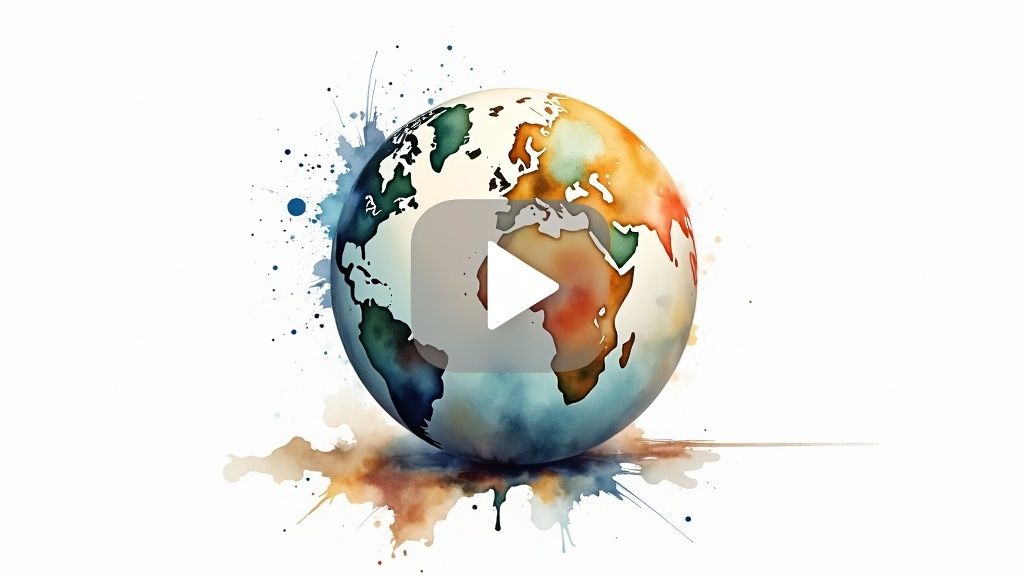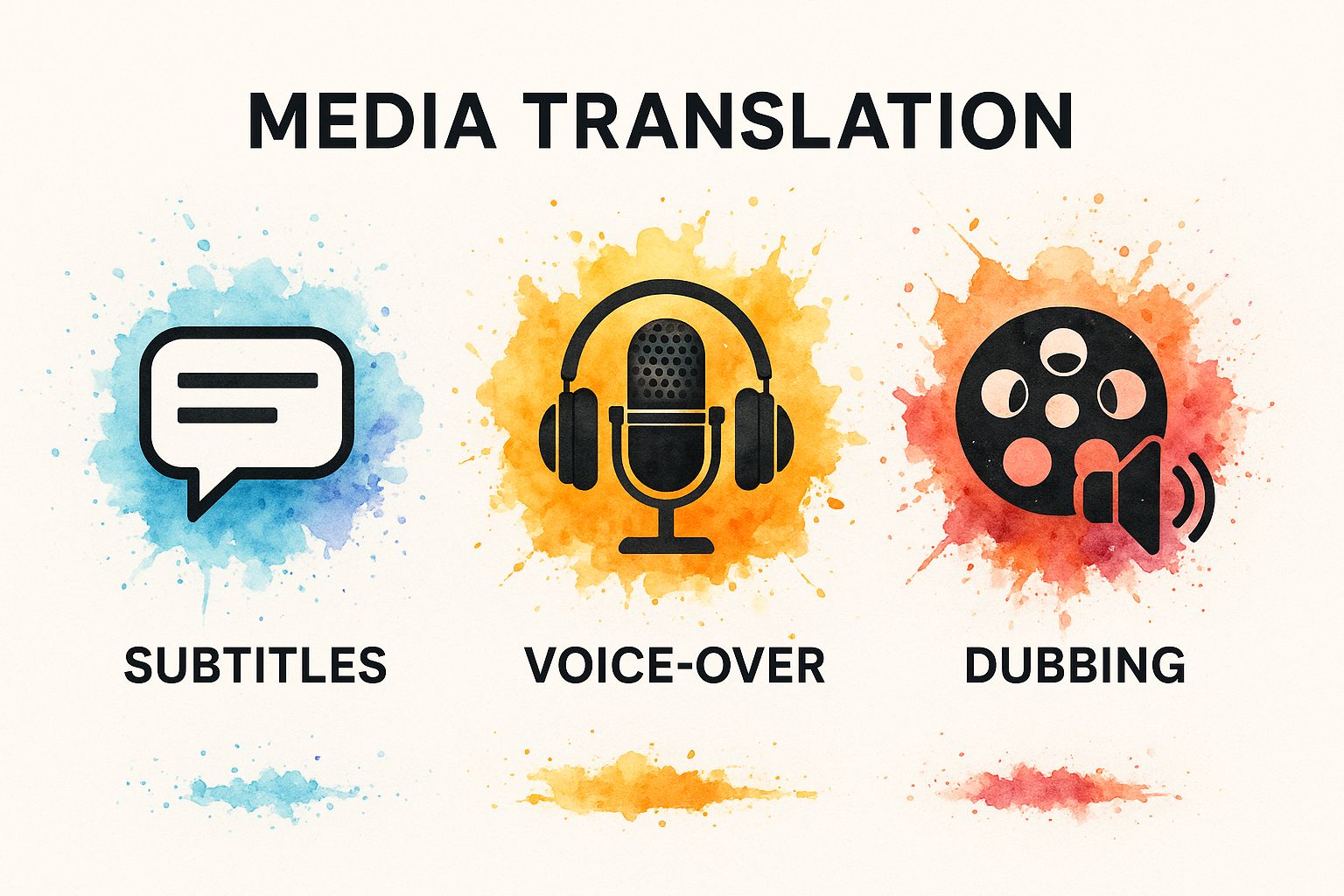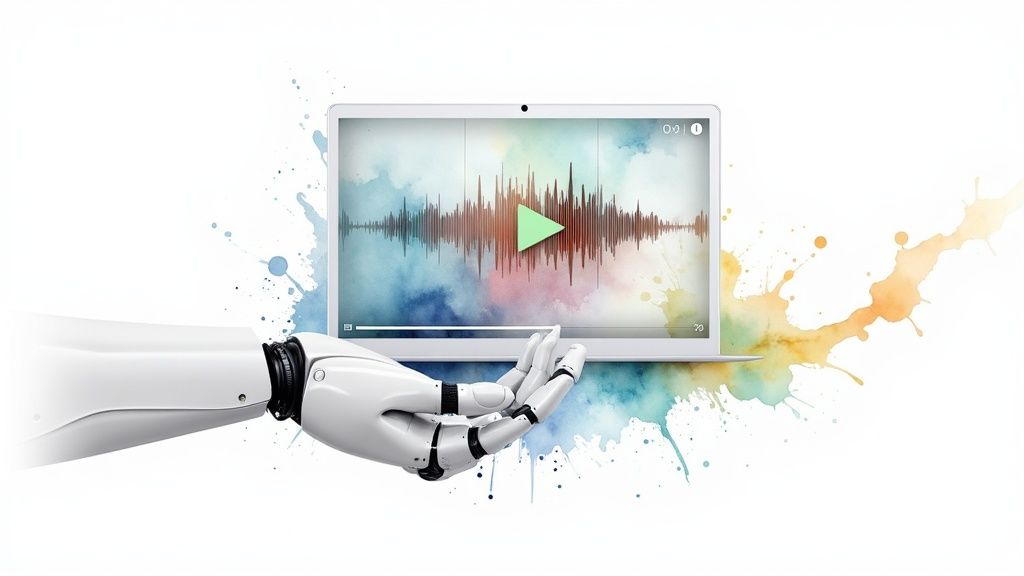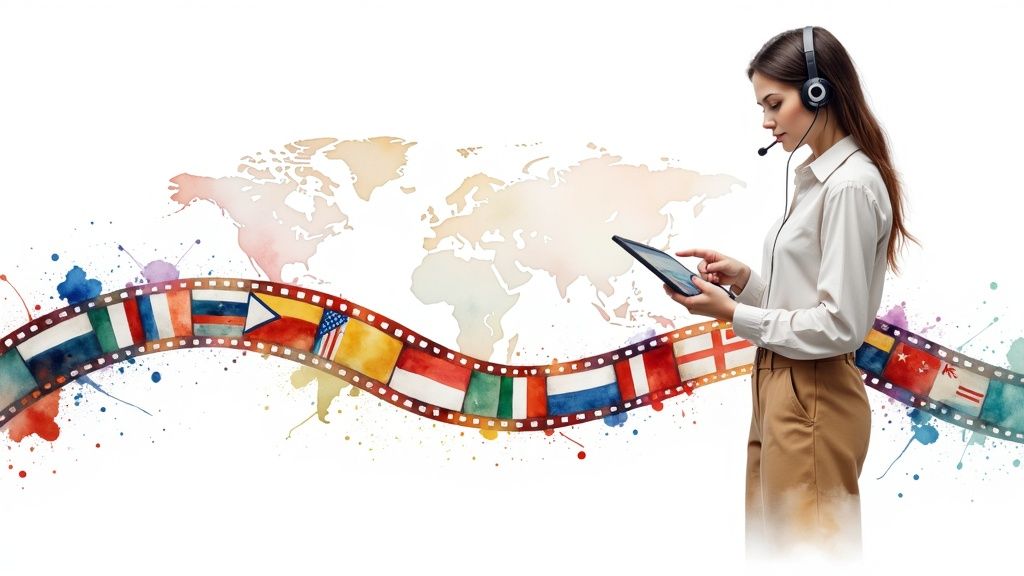Discover how video translation services can unlock global audiences. Learn about subtitling, dubbing, and AI to grow your brand's reach and impact.
In This Article
Subscribe to our newsletter
If you've ever created a great piece of video content—a marketing sizzle reel, a training module, a powerful documentary—you know the effort that goes into it. But what happens after you hit publish? Its impact is instantly limited to a bubble of viewers who speak the same language. That’s where video translation services come in, acting as a key to unlock a global audience.
Unlocking Global Audiences with Video Translation

This is about much more than just a technical task; it's a strategic move. True video translation isn't a simple word-for-word swap. It’s a process of converting all the spoken dialogue and on-screen text into another language while also localizing it.
Localization is the magic ingredient. It’s about adapting your content to fit the cultural nuances of your target market, ensuring your message isn't just understood, but truly felt. It’s the difference between a video that works and a video that connects.
The Scope of Video Translation
The demand for these services is absolutely booming. The overall language services market was valued at USD 60.68 billion in 2022 and is on track to hit nearly USD 96.21 billion by 2032. A huge chunk of that growth is being fueled by the explosion of video content, signaling a major shift in how businesses think about international growth.
Video translation is being applied to a dizzying array of media formats. We're talking about everything from corporate webinars and e-learning courses to blockbuster movies and bite-sized social media clips. It’s also a critical piece of the puzzle for highly visual mediums like the work done through animation services, where precise timing and cultural context are everything to the story.
In essence, video translation is the bridge between your content and a global customer base. It transforms a monologue into a worldwide conversation, fostering deeper engagement and brand loyalty across different cultures.
For any company with its sights set on scaling, video translation is no longer just a "nice-to-have." It’s a core component of a smart global strategy. It allows you to:
- Expand into new international markets by quite literally speaking their language.
- Increase audience engagement with content that feels like it was made just for them.
- Strengthen brand credibility by demonstrating a real commitment to cultural understanding.
Comparing the Core Methods of Video Translation
Once you’ve decided to take your video global, the next big question is how. When you look at professional video translation services, you'll find it's not a one-size-fits-all situation. Instead, you have a few distinct methods to choose from, each with its own quirks, costs, and impact on the viewer.
Think of it like picking the right tool for a job. You wouldn't use a hammer to drive a screw, right? In the same way, the best translation method really boils down to your content, who you're trying to reach, and your budget. The big three are subtitling, dubbing, and voice-over.
This infographic gives you a quick visual breakdown of how each one stacks up.

As you can see, each technique has a clear purpose, from the simple accessibility of subtitles to the complete immersion you get with dubbing. Let's dig a little deeper.
Subtitling: The Accessible Foundation
Subtitling is probably the method you’re most familiar with—it’s simply adding text at the bottom of the screen that translates what’s being said. It's usually the fastest and most budget-friendly option, making it a go-to starting point for a lot of businesses.
But it’s not just about saving money. Subtitling packs some serious advantages. Search engines can actually crawl and index the text in subtitle files (like SRTs), giving your content a fantastic SEO boost for keywords in different languages. Plus, with a staggering 85% of social media videos being watched on mute, subtitles are absolutely essential for grabbing scrollers' attention.
Subtitling is a great fit for:
- Social Media Content: Perfect for engaging users who are scrolling without sound.
- Educational Videos: Lets viewers read and listen at the same time, which can really help with learning and retention.
- SEO-Focused Campaigns: The best way to maximize your video's discoverability in new regions.
Dubbing: The Immersive Experience
At the other end of the spectrum is dubbing, the most intensive and immersive method of them all. This is where you completely replace the original speaker's voice track with a new one, recorded by a native-speaking voice actor. The real art here is making sure the translated dialogue perfectly syncs with the on-screen talent's lip movements.
When done right, this approach gives the audience the most "native" feel possible, as if the video was made just for them in their own language. Because it requires skilled voice actors, sound engineers, and a whole lot of precision, dubbing is definitely the most premium of the video translation services.
Dubbing isn't just a translation; it's a performance. You need voice actors who can capture the original tone, emotion, and timing to create an experience that feels completely authentic to the new audience.
Voice-Over: The Practical Middle Ground
Voice-over strikes a nice balance between the simplicity of subtitling and the full immersion of dubbing. With this method, a translated audio track is recorded and then layered over the original audio. You typically lower the volume of the original track but keep it just audible enough in the background. It's often called "UN-style" voice-over, the kind you hear all the time in documentaries and news reports.
The main difference from dubbing is that voice-over doesn’t have to be perfectly lip-synced. This makes it far less complex and more affordable than full dubbing, while still delivering the message through audio. It's a fantastic choice for content where getting the information across is the top priority, like e-learning courses, corporate presentations, and interviews.
To make the choice a little easier, here’s a side-by-side comparison to help you figure out which method aligns best with your project’s goals and budget.
Comparing Video Translation Methods
| Method | Best For | Audience Impact | Cost & Complexity | SEO Benefit |
|---|---|---|---|---|
| Subtitling | Social media, e-learning, SEO campaigns, content for the hearing-impaired | High accessibility; allows original audio to be heard. Can be distracting for some viewers. | Low. Fastest and most affordable. | High. Subtitle files (SRTs) are indexed by search engines. |
| Voice-Over | Documentaries, corporate training, interviews, news reports | Conveys information clearly in the local language while retaining the original speaker's authenticity in the background. | Medium. More involved than subtitling but less than dubbing. No lip-syncing required. | Low. Audio is not directly indexed. Relies on translated video titles/descriptions. |
| Dubbing | Feature films, TV series, high-production marketing videos, animated content | Highest immersion. Creates a seamless, native viewing experience. | High. Requires professional voice actors, recording studios, and precise lip-syncing. | Low. Audio is not directly indexed. SEO depends on other metadata. |
Ultimately, there's no single "best" method. The right choice depends on what you're trying to achieve, who you're talking to, and the resources you have available.
So, What's the Real Business Case for Translating Your Videos?
Knowing how to translate a video is one thing, but connecting that to real business results is where things get interesting. Investing in video translation isn't just another line item on your budget; it’s a strategic play that can turn a single piece of content into a powerful engine for international growth.
The most obvious benefit is also the most powerful: expanding your market reach. Think about it. Your video, once stuck speaking a single language, can suddenly reach millions of new potential customers. Imagine your e-commerce brand’s product demo, once limited to an English-speaking audience, now landing perfectly with shoppers in Japan, Germany, and Brazil through localized subtitles or voice-overs.
This expansion has a direct impact on audience engagement. When people can watch content in their own language, they’re far more likely to stick around, actually connect with the message, and do something about it. A marketing team, for instance, might see engagement metrics like watch time and click-through rates triple in a new region just by adding culturally sharp subtitles to their social media ads.
Driving Growth and Building Trust
Beyond the immediate engagement bump, video translation is a massive booster for your global SEO. When you add subtitles, you're essentially handing search engines a text-based transcript they can crawl and index. This helps your video show up for relevant keywords in multiple languages, pulling in organic traffic you would have otherwise missed.
But it goes deeper than that. This effort seriously strengthens your brand's credibility around the world. Presenting content in a local language is a sign of respect and commitment to that market. It tells them you’re not just trying to sell them something; you're invested enough to speak their language and get their culture. That builds a level of trust that generic, one-language-fits-all content can never touch.
A translated video does more than just share information. It shows that your brand is committed to being inclusive and culturally aware, which is how you turn passive viewers into loyal advocates.
The market data backs this up. The global demand for video translation is exploding, and it’s all being driven by the insane amount of video we all watch. By 2025, this market is expected to be worth around USD 5 billion, and analysts are calling for a compound annual growth rate of roughly 15% through 2033. You can dig into more of this data over at Data Insights Market Research.
Real-World Scenarios of Video Translation ROI
To see how this plays out in the real world, just look at these examples:
- E-Learning Platforms: A company that sells professional development courses can use voice-overs to make its content accessible to corporate clients anywhere. This move can exponentially grow its user base and revenue streams from a single set of courses.
- Software Companies: A SaaS business can build out a library of subtitled tutorials. This not only improves customer satisfaction by letting people help themselves but also cuts down on the workload for international support teams.
- Media and Entertainment: A production house can use high-quality dubbing to license its series to broadcasters in different countries, unlocking entirely new revenue opportunities from one creative asset.
Each of these scenarios proves the same point: professional video translation isn't an expense—it's a direct investment in your company's future.
How AI Is Changing the Game in Video Translation

The world of video translation services is going through a massive shake-up, and AI is right at the center of it. This isn't some far-off concept anymore; it's a real tool that's fundamentally changing how quickly, cheaply, and widely we can adapt content for global audiences.
Think of AI not as a replacement for human experts, but as an incredibly powerful assistant. It automates the most grinding, repetitive parts of the translation workflow. This partnership lets businesses take on localization projects that were once unthinkable due to cost or complexity, making global communication more realistic than ever before.
The numbers here are staggering. The AI video translation market is expected to balloon to USD 33.4 billion by 2034, leaping from just USD 2.68 billion in 2024. That kind of explosive growth tells you just how essential AI has become for any serious global content strategy. You can dig into more insights on this rapidly growing market at Market.us.
Core AI Technologies in Action
So, how does this actually play out? AI isn't one magic button. It's a collection of specialized technologies that work in concert to smooth out different parts of the video translation process. Each one is built to solve a specific problem, from understanding what's being said to creating entirely new audio.
Three key pieces of tech are doing the heavy lifting:
- Automated Speech Recognition (ASR): This is the starting block. ASR technology listens to the original audio in a video and turns it into a written script. Using powerful AI transcription software, for example, can slash the time and money it takes to get that crucial first draft.
- Machine Translation (MT): With a transcript in hand, machine translation engines can instantly convert the text into one or more target languages. Today's neural machine translation (NMT) has gotten scarily good at grasping context and producing sentences that sound natural.
- AI Dubbing and Voice Synthesis: This is where things get really interesting. AI can now generate synthetic voices to create entirely new audio tracks for dubbing. Some of the most advanced tools can even clone the original speaker's voice, keeping their unique tone and rhythm while making them "speak" a different language.
The New Role for Human Translators
With AI handling so much of the grunt work, the role of the human translator has shifted. It’s become more strategic, zeroing in on the irreplaceable parts of translation that machines still fumble. AI gives you speed; humans give the final product a soul.
AI can churn out a first draft at an incredible pace, but human translators are the essential editors who give it polish. They make sure the final version isn't just linguistically correct but also culturally sharp and emotionally resonant.
This team-up approach lets human experts focus their talents where it matters most:
- Cultural Nuances: Catching and adapting idioms, humor, and cultural references that AI would likely botch.
- Creative Adaptation: Making sure the brand's voice and the core message land just right in the new language.
- Quality Assurance: Doing a final check to catch any subtle errors in context, tone, or timing.
This "human-in-the-loop" model really is the best of both worlds. It gives businesses the raw efficiency needed to scale their video localization, all while preserving the high quality that's non-negotiable for building a credible global brand.
How to Choose the Right Translation Partner
Picking a partner for your video translation services isn't just about finding a vendor. It’s about choosing the team that will carry your brand's voice across borders. Get it right, and your message lands with clarity and power. Get it wrong, and you risk confusing your audience or, worse, causing a brand-damaging misstep.
You have to look beyond the price tag and really dig into what they can do. Think of it like hiring a global ambassador for your content—you need total confidence they’ll handle your message with the care it deserves.
Evaluate Linguistic and Cultural Expertise
First things first: the quality of the language. This is non-negotiable. Don't even consider a provider that doesn't use native-speaking translators for your target language.
A native speaker just gets it. They understand the subtle nuances, the local idioms, and the cultural inside jokes that automated tools and non-native speakers almost always miss. This is the difference between a translation that’s technically correct and one that actually connects with a real person.
But it goes deeper than just the words. Ask them how they approach cultural localization. A great partner doesn't just translate; they adapt.
- Regional Dialects: Do they know the difference between the Spanish spoken in Madrid versus Mexico City? It matters.
- Cultural Sensitivity: What’s their process for flagging visuals or ideas that might not land well—or could even be offensive—in another culture?
- Local Market Knowledge: Are their translators plugged into the current trends and slang of the target region?
When a provider gets this right, your video feels like it was made for the local audience, not just translated at them.
Scrutinize Technical Capabilities and Quality Assurance
Your potential partner also needs the technical chops to handle your projects without causing a headache. Make sure they can work with your video formats, file types, and delivery platforms. A smooth technical workflow saves you from frustrating delays and expensive re-dos later on.
Just as critical is their quality assurance (QA) process. A solid QA system isn't a "nice-to-have"; it’s an absolute must for any professional video translation service. It should be a multi-layered process.
A solid quality assurance process is your safety net. It should involve more than one person and include linguistic reviews, technical checks for timing and sync, and a final verification to ensure every element aligns perfectly with your project goals.
When you're vetting a partner, ask them to walk you through their QA workflow. Who reviews the final product? Is there a separate editing and proofreading step? How do they handle feedback if something isn't right?
Transparency here is a huge green flag. A partner who can clearly explain their process is one you can trust to deliver consistent, high-quality results for your global content.
Integrating Translation into Your Video Workflow
Thinking about translation after you’ve finished your video is one of the most common—and costly—mistakes a global team can make. The smart move? Build localization right into your production process from day one. When you do this, translation stops being a frantic, last-minute scramble and becomes a seamless part of your video’s DNA.
When you start thinking globally from the script-writing stage, you save yourself a world of headaches later on. It’s a simple mental shift: craft your message from the get-go with a multicultural audience in mind. This foresight helps you sidestep localization roadblocks before they even pop up, making the whole process incredibly smooth.
Preparing Your Content for Localization
The first step is what we call "internationalization." This just means prepping your original video and script to be as easy as possible for translators to adapt. A well-prepared script is the bedrock of a great translation, no matter the language. The idea is to hand over content that’s crystal clear, leaving no room for misinterpretation.
To get your content ready, focus on a few key things:
- Avoid Idioms and Slang: Phrases like "hit a home run" or "bite the bullet" are translator nightmares. They rarely have a direct equivalent and can leave global audiences scratching their heads. Stick to clear, universal language.
- Keep On-Screen Text Editable: If you have text overlays, lower thirds, or any other graphics with words, don't burn them into the video file. Instead, provide these as separate, editable layers. This lets translators pop in the new text without needing to be a video editing wizard.
- Provide a Brand Glossary: You know your brand best. Put together a simple glossary of key terms, product names, and any company-specific jargon. This is a huge help for ensuring your brand voice stays consistent and accurate everywhere.
Planning for localization early isn't just about making the translator's job easier. It’s about protecting the integrity of your brand's voice and message as you expand into new markets.
Establishing a Technical and Review Workflow
Once your content is ready, you need a solid process for the technical handoff and review cycle. A sloppy handoff or a vague review process is where projects go off the rails, leading to delays and work you’re not happy with. A clear, structured workflow keeps everyone on the same page.
For a project that runs like clockwork, set up a clear process:
- Prepare Technical Files: For subtitles, export a clean transcript with accurate timecodes. If you're doing dubbing, you'll need to provide an M&E track (which stands for "music and effects"). This is simply your final audio mix with the original dialogue stripped out, making it easy to drop the new voice-over in.
- Set Up a Clear Review Cycle: Decide upfront who is going to review the translated materials. The ideal person is a native speaker who also gets your brand. They can check not just for grammatical accuracy but also for cultural nuances.
- Provide Contextual Information: This one is critical. Always give your video translation services partner access to the final video. A script is just words on a page, but seeing the visuals helps them capture the full context and emotion, which leads to a far more powerful translation.
Frequently Asked Questions
How Much Do Video Translation Services Cost?
The price tag really comes down to the method you pick. Subtitling is usually the most budget-friendly route, whereas professional dubbing sits at the top end of the price spectrum.
Of course, the video’s length and the languages you're translating between are huge factors. While AI services can get you started for a lower upfront cost, you'll find that human-led services deliver a far more polished and culturally nuanced final product. It's always best to ask for a custom quote that fits your specific project.
Which Is Better for SEO: Subtitles or Dubbing?
When it comes to search engine optimization, subtitles are the hands-down winner.
Search engines can easily read and index the text in your subtitle files (like a .SRT file), which helps your video show up in search results for keywords in different languages. Dubbing definitely creates a better viewing experience—which can indirectly help your SEO—but it doesn't give you that direct, text-based boost that subtitles provide.
How Long Does It Take to Translate a Video?
The timeline can vary quite a bit. AI can crank out a subtitle file in a matter of minutes, which is perfect when you're in a hurry.
For a professional human translation of a 10-minute video, including a proper quality check, you're more likely looking at a few business days. High-quality dubbing is the most involved process of all, often taking a week or more to handle casting, recording, and mixing everything together just right.
Transform your articles and audio into engaging videos effortlessly with Aeon. Discover how our AI-driven platform can scale your content creation at https://www.project-aeon.com.


.jpg)